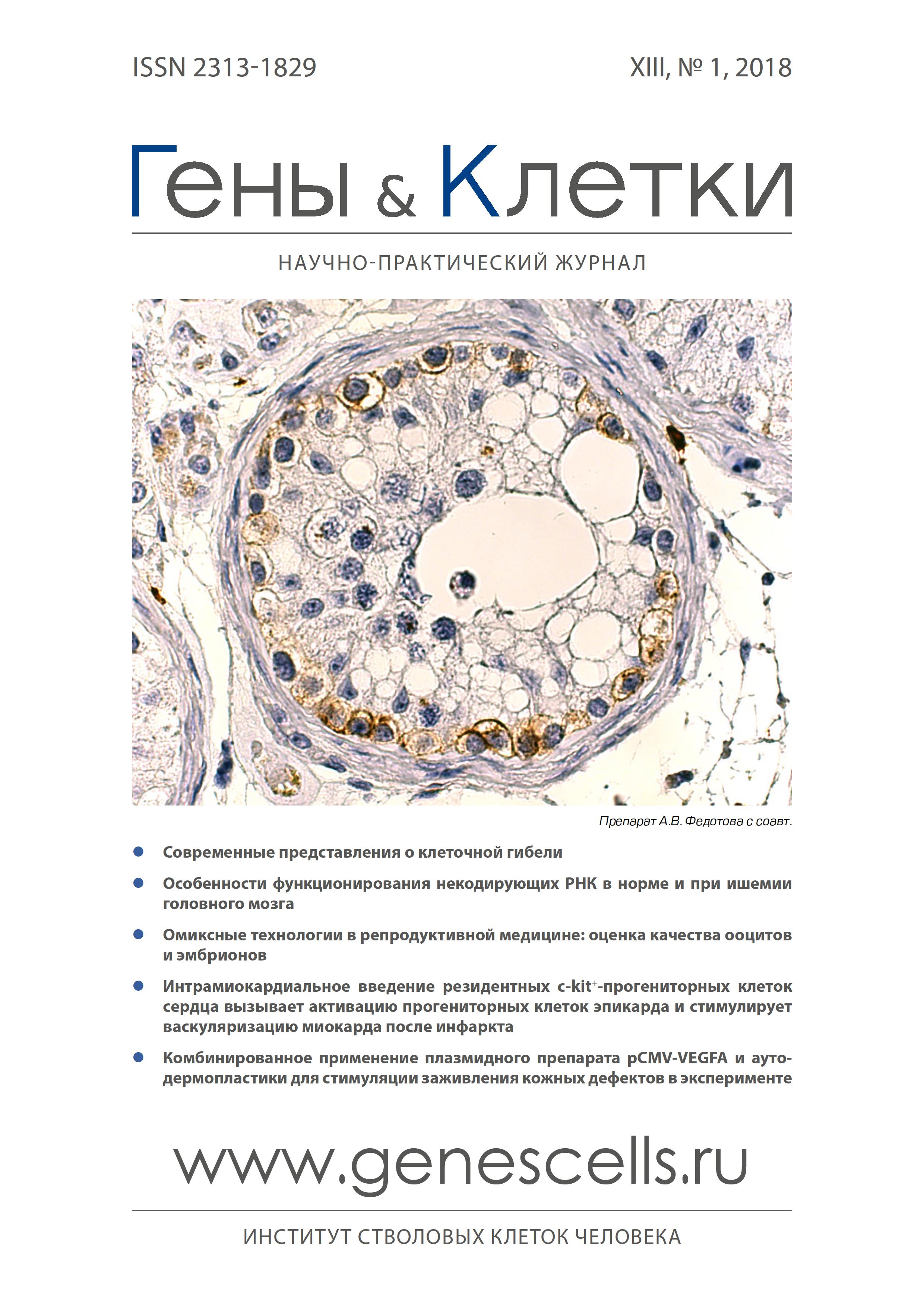Expression of CD117 receptor in male gonads in traumatic brain injury
- Authors: Fedotov A.V1, Astrakhantsev A.F2, Mazurova M.P2
-
Affiliations:
- Bureau of Forensic Medicine, Ryazan
- NA. Semashko Central Clinical Hospital № 2
- Issue: Vol 13, No 1 (2018)
- Pages: 70-74
- Section: Articles
- Submitted: 05.01.2023
- Published: 15.03.2018
- URL: https://genescells.ru/2313-1829/article/view/120730
- DOI: https://doi.org/10.23868/201805008
- ID: 120730
Cite item
Abstract
Using the conventional histological methods (staining with hematoxylin and eosin), morphometric (counting the percentage of tubules with impaired spermatogenesis, measuring the crosssectional area of the tubules), as well as immunohistochemical methods of investigation (immunohistochemical staining with antibodies to C-kit (CD117), the gonads of 5 patients, who died from a craniocerebral trauma on the 15-35 day after the injury, and 6 patients who died from a craniocerebral injury at the scene. In both groups, a positive membranous staining of the spermatogonia of the basal section of the epithelio-spermatogenic layer is found, which is more pronounced in individuals who died in the long-term after traumatic brain injury, which may indicate activation of the proliferative activity of the spermatogonial population of regenerative nature. CD117 positive cell, similar to Cajal cells, are also detected in the walls of convoluted seminiferous tubules, located along the periphery of blood vessels, among interstitial endocrinocytes. The number of interstitial endocrinocytes, along with this, increases in the feces of the sex glands of individuals who died in the long-term after the craniocerebral trauma, which indicates their hyperplasia, as a compensatory adaptive response in response to atrophic changes in the epithelio-spermatogenic layer (so-called. "mixed atrophy of the testis”). CD117 positive cells, interacting with smooth muscle cells of the wall of convoluted seminiferous tubules, can participate both in the movement of spermatogenic cells from the basal membrane to the lumen of the tubule, and participate in the formation of the so-called. "Waves of spermatogenesis”, ensuring the movement of spermatogenic cells from the periphery to the middle zone.
Full Text
About the authors
A. V Fedotov
Bureau of Forensic Medicine, Ryazan
A. F Astrakhantsev
NA. Semashko Central Clinical Hospital № 2
Email: afastra@mail.ru
M. P Mazurova
NA. Semashko Central Clinical Hospital № 2
References
- Hanani M., Freund H.R. Interatitial cells of Cajal - their role in pacing and signal transmission in the digestive system. Acta Physiol. Scand. 2000; 170(3): 177-90.
- Metzger R., Schuster T., Till H. et al. Cajal-like cells in the upper urinary tract: comparative study in various species. Pediatr. Surg. Int. 2005; 21(3): 169-74.
- Exintaris B., Klemm M.F., Lang R.J. Spontaneous slow wave and contractile activity of the guinea pig prostate. J. Urol. 2002; 168: 315-22.
- Solari V., Piotrowska A.P., Puri P. Altered expression of interstitial cells of Cajal in congenital ureteropelvic junction obstruction. J. Urol. 2003; 170: 2420-2.
- Петров С.В., Райхлин Н.Т. Руководство по иммуногистохимической диагностике опухолей человека. 4-е изд. доп. и перераб. Казань: Татмедиа; 2012.
- Piaseczna-Piotrowska A.M., Dzieniecka M., Kulig A. et al. Different distribution of c-kit positive interstitial cells of Cajal-like in children’s urinary bladders. Folia Histochem. Cytobiol. 2011; 49(3):431-5.
- Strohmeyer T., Reese D., Press M. et al. Expression of the protooncogene c-kit and its ligand stem cell factor (SCF) in normal and malignant tissue of the human testicles. J. Urol. 1995; 153: 511-5.
- Prabhu S.M., Meistrich M.L., McLaughlin E.A. et al. Expression of c-kit receptor and protein mRNA in the developing, adult and irradiated rodent ovary. Reprod. 2006; 131: 489-99.
- Rodriguez H., Espinoza-Navarro O., Sarabia L. et al. Histological and functional organization in human testicle expression of receptors c-kit and androgens. Int. J. Morphol, 2008; 26(3): 603-8.
- Hasirci E., Turunc T., Bal N. et al. Hasirci E., Turunc T., Bal N. Distribution and number of Cajal-like cells in testis tissue with azoospermia. Kaohsiung J. Med. Sci. 2017; 33(4): 181-6.
- World Medical Association Declaration of Helsinki Ethical Principles for Medical Research Involving Human Subjects. November 27, 2013.
- Rupert P.A. The Cycle of the Seminiferous Epithelium in Humans: A Need to Revisit? J. Androl. 2008; 29: 469-87.
- Прошина Ю.В., Папков В.Г. Структура гипоталамических ядер при тяжелой черепно-мозговой травме. Судебно-медицинская экспертиза 2007; 1: 13-5.
- Карашева Б.Г., Кибрик Н.Д. Сексуальные дисфункции в отдаленном периоде черепно-мозговой травмы. Соц. и Клин. Психиатр. 2013; 23: 106-9.
- Астраханцев А.Ф. Нарушения сперматогенеза у больных атеросклерозом. В: Материалы Юбилейной научной конференции, Россия. Рязань; 2000. с. 38-9.
- Krupnov N., Astrakhantsev A. Morphological changes of testis in atherosclerosis. Virchows Arch. 2012; 461 Suppl 1: 291-2.
- Крупнов Н.М. Структурные изменения мужских половых желез при дезоморфиновой наркомании. В: Материалы форума Мужское здоровье и долголетие, Россия. Москва; 2011. с. 50.
- Федотов А.В., Крупнов Н.М., Мазурова М.П. и соавт. Морфологические изменения мужских половых желез в различные сроки после черепно-мозговой травмы. В: Материалы V Съезда Российского общества патологоанатомов, Россия. Челябинск; 2017. с. 339.
- Miettinen M., Lasota J. KIT (CD117): a review on expression in normal and neoplastic tissues, and mutations and their clinicopathologic correlation. Appl. Immunohistochem. Mol. Morphol. 2005; 13(3): 205-20.
- Bergman M. Physiology of Spermatogenesis. In: Schill W.B., Comhaire F.N., Hargreave T.B., editors. Andrology for the clinician. 1st ed. Berlin: Springer; 2006. p. 272-81.
Supplementary files










